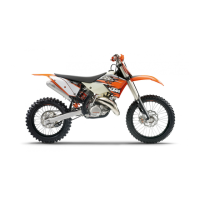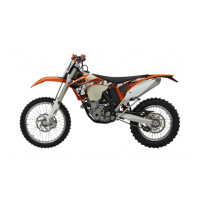MAINTENANCE WORK ON CHASSIS AND ENGINE 73
Info
Even when there is no load on the battery, it still loses power steadily.
The charge state and the type of charge are very important for the service life of the battery.
Rapid recharging with a high charging current shortens the battery's service life.
If the charging current, charging voltage and charging time are exceeded, electrolyte escapes through the safety valves. This
reduces the battery capacity.
If the battery is depleted from starting the vehicle repeatedly, the battery must be charged immediately.
If the battery is left in a discharged state for an extended period, it will become over-discharged and sulfate, destroying the
battery.
The battery is maintenance-free, i.e., the acid level does not have to be checked.
– Switch off all power consumers and switch off the engine.
– Remove the seat. ( p. 74)
– Disconnect the minus (negative) cable of the battery to avoid damage to the motor-
cycle's electronics.
400240-10
– Connect the battery charger to the battery. Switch on the battery charger.
Battery charger (58429074000)
You can also use the battery charger to test rest potential and start potential of the
battery, and to test the alternator. With this device, you cannot overcharge the bat-
tery.
Info
Never remove the lid .
Charge the battery with at most 10% of the capacity specified on the bat-
tery .
– Switch off the charger after charging. Disconnect the battery.
Guideline
The charge current, charge voltage and charge time must not be exceeded.
Charge the battery regularly when the
motorcycle is not in use
3 months
– Mount the seat. ( p. 75)
11.74Removing a fuse (250 EXC AUS/XC‑W/XC, all 300 models)
– Switch off all power consumers and switch off the engine.
– Remove the air filter box lid. ( p. 81)
400270-10
– Remove the protection cover .
Info
The fuse is located in the starter relay under the filter box cover.
– Remove the fuse .
11.75Replacing the fuse (250 EXC AUS/XC‑W/XC, all 300 models)
Warning
Fire hazard The electrical system can be overloaded by the use of incorrect fuses.
– Use only fuses with the prescribed amperage. Never by-pass or repair fuses.

